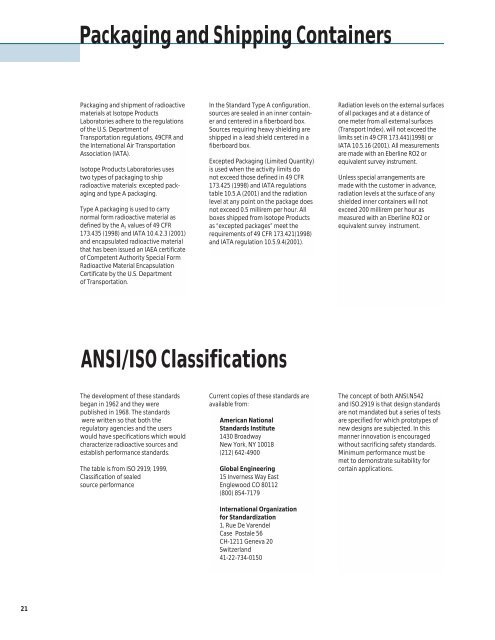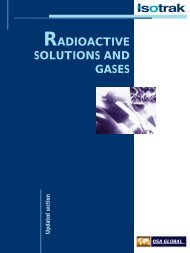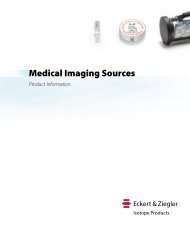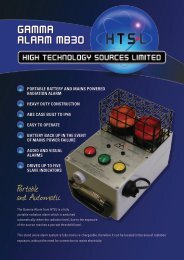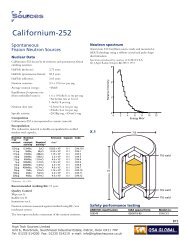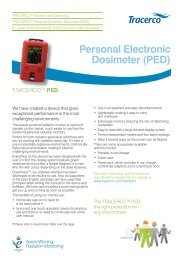Sources for Medical Imaging - High Technology Sources Ltd
Sources for Medical Imaging - High Technology Sources Ltd
Sources for Medical Imaging - High Technology Sources Ltd
You also want an ePaper? Increase the reach of your titles
YUMPU automatically turns print PDFs into web optimized ePapers that Google loves.
Packaging and Shipping Containers<br />
Packaging and shipment of radioactive<br />
materials at Isotope Products<br />
Laboratories adhere to the regulations<br />
of the U.S. Department of<br />
Transportation regulations, 49CFR and<br />
the International Air Transportation<br />
Association (IATA).<br />
Isotope Products Laboratories uses<br />
two types of packaging to ship<br />
radioactive materials: excepted packaging<br />
and type A packaging.<br />
Type A packaging is used to carry<br />
normal <strong>for</strong>m radioactive material as<br />
defined by the A2 values of 49 CFR<br />
173.435 (1998) and IATA 10.4.2.3 (2001)<br />
and encapsulated radioactive material<br />
that has been issued an IAEA certificate<br />
of Competent Authority Special Form<br />
Radioactive Material Encapsulation<br />
Certificate by the U.S. Department<br />
of Transportation.<br />
In the Standard Type A configuration,<br />
sources are sealed in an inner container<br />
and centered in a fiberboard box.<br />
<strong>Sources</strong> requiring heavy shielding are<br />
shipped in a lead shield centered in a<br />
fiberboard box.<br />
Excepted Packaging (Limited Quantity)<br />
is used when the activity limits do<br />
not exceed those defined in 49 CFR<br />
173.425 (1998) and IATA regulations<br />
table 10.5.A (2001) and the radiation<br />
level at any point on the package does<br />
not exceed 0.5 millirem per hour. All<br />
boxes shipped from Isotope Products<br />
as “excepted packages” meet the<br />
requirements of 49 CFR 173.421(1998)<br />
and IATA regulation 10.5.9.4(2001).<br />
Radiation levels on the external surfaces<br />
of all packages and at a distance of<br />
one meter from all external surfaces<br />
(Transport Index), will not exceed the<br />
limits set in 49 CFR 173.441(1998) or<br />
IATA 10.5.16 (2001). All measurements<br />
are made with an Eberline RO2 or<br />
equivalent survey instrument.<br />
Unless special arrangements are<br />
made with the customer in advance,<br />
radiation levels at the surface of any<br />
shielded inner containers will not<br />
exceed 200 millirem per hour as<br />
measured with an Eberline RO2 or<br />
equivalent survey instrument.<br />
ANSI/ISO Classifications<br />
The development of these standards<br />
began in 1962 and they were<br />
published in 1968. The standards<br />
were written so that both the<br />
regulatory agencies and the users<br />
would have specifications which would<br />
characterize radioactive sources and<br />
establish per<strong>for</strong>mance standards.<br />
The table is from ISO 2919; 1999,<br />
Classification of sealed<br />
source per<strong>for</strong>mance<br />
Current copies of these standards are<br />
available from:<br />
American National<br />
Standards Institute<br />
1430 Broadway<br />
New York, NY 10018<br />
(212) 642-4900<br />
Global Engineering<br />
15 Inverness Way East<br />
Englewood CO 80112<br />
(800) 854-7179<br />
International Organization<br />
<strong>for</strong> Standardization<br />
1, Rue De Varendel<br />
Case Postale 56<br />
CH-1211 Geneva 20<br />
Switzerland<br />
41-22-734-0150<br />
The concept of both ANSI.N542<br />
and ISO.2919 is that design standards<br />
are not mandated but a series of tests<br />
are specified <strong>for</strong> which prototypes of<br />
new designs are subjected. In this<br />
manner innovation is encouraged<br />
without sacrificing safety standards.<br />
Minimum per<strong>for</strong>mance must be<br />
met to demonstrate suitability <strong>for</strong><br />
certain applications.<br />
21


